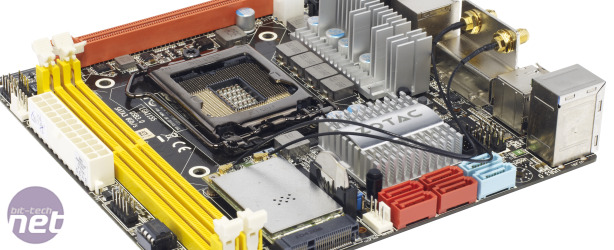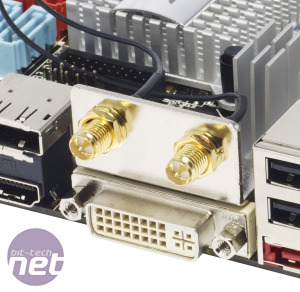
Performance Analysis
It isn’t enough to simply cram a load of features onto a tiny board, it also has to perform to a reasonable level. Unfortunately, the Zotac fell at the first hurdle in this regard, as the board took an inordinate amount of time to boot into Windows.This, we discovered, was due to some sort of BIOS conflict with the USB SteelSeries Xai mouse we were using for testing, which caused the board to stall at the Zotac splash screen. The problem resolved itself when we used other mice, but we’ve never seen this problem before when using either the Xai or any other mouse. The BIOS at least managed to run our test memory at the maximum 1,333MHz that the P67 chipset supports.
The Zotac board scored a respectable 1,900 points overall in our Media Benchmarks, which is on a par with some of the ATX-sized LGA1155 boards we’ve tested. This is an impressive result for a board that’s built with size rather than speed in mind. The Zotac wasn’t quite as nippy when it came to storage, however, as it achieved decidedly average read and write speeds of 301MB/sec and 226MB/sec respectively over its SATA 6Gbps ports.
The Zotac also proved to be merely average when it came to gaming, managing a minimum of 33fps and an average of 59fps in Crysis. This is slightly slower than both the other LGA1155 board we’ve reviewed so far, though both of them have been full fat P67 based ATX boards.
Despite the fact that Intel has disabled overclocking on the H67 chipset, we still couldn’t resist having a rummage around in the BIOS to determine if Zotac had devised with any inventive ways to squeeze extra performance out of the board. Unfortunately, all we could find was a menu that allowed slight increases in the memory and chipset voltages – these are only of use if you encounter stability problems by using ropey kit.
Conclusion
The Zotac H67-ITX WiFi packs on-board WiFi, six SATA ports, four USB 3 ports and robust VRM circuitry into its tiny frame, but is nearly double the price of other mini-ITX LGA1155 boards. At least the Zotac was fast, and the high level of integration means that it could form the basis of a neat media PC or a tiny workhorse PC.However, £120 is too much to pay for a motherboard for these types of PC – a USB WiFi dongle costs less than £30 and six SATA devices won’t fit into most micro-ATX cases, let alone mini-ITX ones. Even the USB 3 ports could be redundant, as you can easily transfer large video files over your home network. While we see the merit in the high-quality VRMs, you'd have to be loaded to build a mini-ITX PC around this motherboard.
- Speed
- x
- x
- x
- x
- x
- x
- x
- -
- -
- -
- 7/10
- Features
- x
- x
- x
- x
- x
- x
- x
- x
- -
- -
- 8/10
- Value
- x
- x
- x
- x
- x
- x
- x
- -
- -
- -
- 7/10
- Overall
- x
- x
- x
- x
- x
- x
- x
- -
- -
- -
- 7/10

MSI MPG Velox 100R Chassis Review
October 14 2021 | 15:04











Want to comment? Please log in.